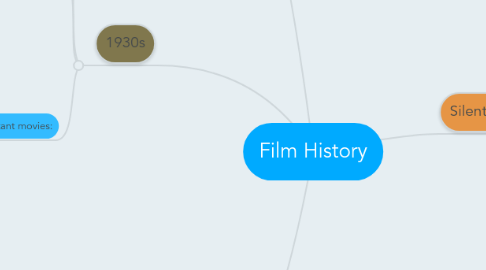
1. Hollywood as Industry
1.1. Since the 1920s, one industry, Hollywood, has dominated the world. That’s why the history of the film industry begins there, not because it has produced the best films, but because it has forced all other national cinemas to begin by dealing with the power of Hollywood as an industry
1.1.1. The vaudeville (or variety) hall provided the first business outlet, which gave way to the nickelodeons, the thousands of theatres that from 1905 to 1910 presented hour-long all-movie shows.
1.1.1.1. Finally, Hollywood came to stand for world distribution and presentation with a sudden technical change – the coming of sound.
1.1.1.1.1. 1930s-1940s:Filmmaking, distribution, and exhibition were dominated by five theatre corporations: Paramount, Loew’s, Fox Film (later 20th Century Fox), Warner Bros., and RKO.
1.2. 1.PRODUCTION: The creation of a film. Since the 1910s this has been done in studios in the L.A. area.
1.3. 2.DISTRIBUTION: Once films are made, Hollywood companies sell their films around the world. Worldwide distribution is the basis of Hollywood’s power and no other film industry has been as far-reaching for as long as Hollywood.
1.4. 3.PRESENTATION: Finally, movies are watched in theatres and cinemas, and on television at home. Since the 1960s most people see most movies at home on TV.
1.4.1. Once television programming commenced in the U.S. after WWII, movie fans stayed at home, attracted by “free” television entertainment. Going out to the movies suddenly became a relatively expensive night out, requiring a long journey downtown. Television entertainment was so much cheaper.
1.4.1.1. During the 1950s and 1960s the film industry adjusted to these new circumstances, first with auto theatres (drive-ins) and then with cinemas in shopping-malls, the long-term solution.
1.4.1.1.1. By the mid-1970s Hollywood as an industry had adjusted to a new world of flexible film production and the new suburban audiences captured by TV. A new era for Hollywood as a film industry began in the mid-1970s following the innovation of the blockbuster, exemplified by such films as Jaws (1975) and Star Wars (1977).
2. 1930s
2.1. Gangster Films
2.1.1. Scarface(1932)
2.2. Horror Flims
2.2.1. Dracula(1931)
2.2.2. Frankestein(1931)
2.2.3. The Mummy(1932)
2.2.4. Freaks(1932)
2.3. Other important movies:
2.3.1. Grand Hotel(1932)
2.3.2. Gone with the wind(1939)
2.3.3. Duck soup(1933)
2.3.4. Tarzan the Ape man(1932)
2.3.5. King Kong(1933)
2.3.6. Robin Hood(1938)
3. 1940s
3.1. Important Movies of this time
3.1.1. Casablanca(1942)
3.1.2. The Great Dictator by Charlie Chaplin in which imitates a communist dictator.
3.1.3. Citizen Kane
3.1.4. The Maltese Falcon
3.1.5. The Thief of Bagdad
3.1.6. The Big Sleep
3.1.7. Rio Grande
3.1.8. The Shadow of a doubt
3.1.9. The Bicycle Thief
3.1.10. Rome
3.1.11. Olivers
4. Silent period(1895-1929)
4.1. The Lumiere Brothers:In 1895, the Lumière brothers invented a machine, the Cinématographe, that could shoot, print, and project moving pictures.
4.1.1. the Lumières held a public screening of five of their first films, including Workers Leaving the Lumière Factory and The Arrival of a Train at the Station.
4.2. George Méliès: Méliès is considered the first to explore the medium’s potential for fictional storytelling.
4.2.1. A Trip to the moon(1902)Méliès created whimsical adventure stories that were shot on elaborate stage sets and that became popular for their sight gags and otherworldly imagery. :
4.3. Edwin S. Porter:
4.3.1. Life of a Fireman and The Great Train Robbery(1903), feature groundbreaking editing techniques such as simultaneous parallel action, elliptical shifts in time and location, and cutting away from scenes before completion. These films were the first to use the shot,
4.4. Charlie Chaplin:Between 1914 and 1918, Chaplin became the first international film superstar when he wrote, directed, and starred in short films as “the Tramp,” a comic figure with baggy pants, oversized shoes, cropped mustache, derby suit, and cane.
4.4.1. Chaplin’s criticism of authority figures, moral and political orthodoxies, and material and psychological divisions between classes and genders reached its peak in later feature-length works, such as City Lights (1931) and Monsieur Verdoux (1947). Such as Modern Times(1936)
4.5. Carl Theodor Dreyer
4.5.1. The Danish director Dreyer directed what many consider to be the greatest silent film ever made, The Passion of Joan of Arc (1928), a triumph of realism and spiritual expressiveness.
4.6. Major Movements
4.6.1. German Expressionism: Influenced by the art movements of expressionism and constructivism, German filmmakers working for the Berlin-based mega-studio Ufa created a series of important films from 1919–1933, until Hitler came to power.
4.6.1.1. The Cabinet of Dr. Caligari(1919)
4.6.2. Soviet montage: Soviet filmmakers saw editing as the foundation of film art and therefore used the shot, not the scene, as the primary unit of film language and meaning.
4.6.2.1. Battleship Potemkin(1925)
4.6.3. French avant-garde: Influenced by Dadaism, surrealism, and poetic naturalism, French experimental filmmakers made a series of innovative films that explored the medium as a purely visual form, constructed surrealist non-narrative dreamscapes, and used symbolism to externalize the psychology of their characters.
4.6.3.1. Un Chien Andalou(1929)
